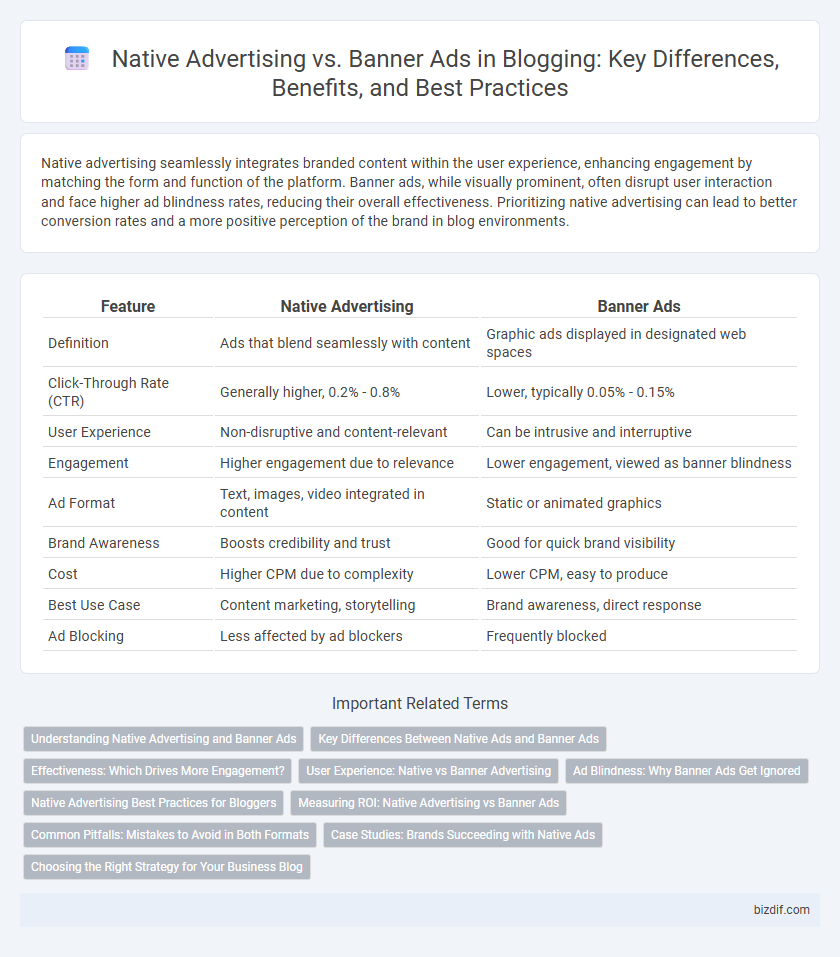Native advertising seamlessly integrates branded content within the user experience, enhancing engagement by matching the form and function of the platform. Banner ads, while visually prominent, often disrupt user interaction and face higher ad blindness rates, reducing their overall effectiveness. Prioritizing native advertising can lead to better conversion rates and a more positive perception of the brand in blog environments.
Table of Comparison
| Feature | Native Advertising | Banner Ads |
|---|---|---|
| Definition | Ads that blend seamlessly with content | Graphic ads displayed in designated web spaces |
| Click-Through Rate (CTR) | Generally higher, 0.2% - 0.8% | Lower, typically 0.05% - 0.15% |
| User Experience | Non-disruptive and content-relevant | Can be intrusive and interruptive |
| Engagement | Higher engagement due to relevance | Lower engagement, viewed as banner blindness |
| Ad Format | Text, images, video integrated in content | Static or animated graphics |
| Brand Awareness | Boosts credibility and trust | Good for quick brand visibility |
| Cost | Higher CPM due to complexity | Lower CPM, easy to produce |
| Best Use Case | Content marketing, storytelling | Brand awareness, direct response |
| Ad Blocking | Less affected by ad blockers | Frequently blocked |
Understanding Native Advertising and Banner Ads
Native advertising blends seamlessly with website content, enhancing user experience by appearing as part of the editorial flow, while banner ads are visually distinct, designed to grab attention through bold graphics and clear calls-to-action. Native ads typically deliver higher engagement rates due to their non-disruptive nature, integrating naturally within blog posts or social media feeds. Banner ads rely on traditional display placement, often positioned in sidebars or headers, making them more noticeable but sometimes less effective in maintaining long-term reader interest.
Key Differences Between Native Ads and Banner Ads
Native advertising seamlessly integrates promotional content within the user experience by matching the form and function of the platform, whereas banner ads are distinct graphic displays designed to capture attention through visual prominence. Native ads tend to generate higher engagement rates due to their less intrusive nature, while banner ads often rely on bold visuals and placement for immediate visibility. The key difference lies in user perception; native ads appear as natural content, enhancing trust, whereas banner ads can be perceived as disruptive or overt advertisements.
Effectiveness: Which Drives More Engagement?
Native advertising consistently drives higher engagement rates compared to banner ads due to its seamless integration within content, making it less intrusive and more relevant to viewers. Studies show that native ads achieve click-through rates up to 8.8 times higher than traditional banner ads, enhancing user interaction and brand recall. The contextual alignment of native ads fosters trust and encourages deeper audience connection, resulting in more meaningful engagement.
User Experience: Native vs Banner Advertising
Native advertising seamlessly integrates with blog content, offering a less intrusive experience that maintains user engagement and reduces ad blindness. Banner ads, often visually disjointed from surrounding content, can disrupt reading flow and lead to higher bounce rates. Prioritizing native ads boosts user experience by aligning ad format with natural content consumption patterns, enhancing both click-through rates and time spent on site.
Ad Blindness: Why Banner Ads Get Ignored
Banner ads often suffer from ad blindness because users subconsciously ignore them due to their repetitive placement and superficial design, leading to decreased click-through rates. Native advertising, which seamlessly integrates with content and matches the platform's style, effectively combats ad blindness by providing a less intrusive and more engaging user experience. Studies show native ads can increase user engagement by up to 53%, highlighting their advantage over traditional banner advertisements.
Native Advertising Best Practices for Bloggers
Native advertising integrates seamlessly with blog content, enhancing reader engagement without disrupting the user experience. Effective native ads rely on relevance, matching the blog's tone and audience interests, while maintaining transparency through clear labeling to build trust. Optimizing placement within articles and leveraging high-quality visuals increases click-through rates and boosts conversion for bloggers.
Measuring ROI: Native Advertising vs Banner Ads
Measuring ROI for native advertising versus banner ads reveals that native ads typically generate higher engagement rates and better click-through rates due to their seamless integration with content, leading to more effective brand awareness and conversions. Banner ads often suffer from banner blindness, resulting in lower interaction and less accurate ROI tracking, as users tend to ignore static visuals. Advanced analytics tools that track user behavior and conversion paths are essential for accurately assessing the performance and return on investment of both advertising formats.
Common Pitfalls: Mistakes to Avoid in Both Formats
Common pitfalls in native advertising include creating overly deceptive content that blurs the line between ads and editorial material, leading to reader distrust. Banner ads often suffer from ignoring mobile optimization and using intrusive placements that cause banner blindness and reduce click-through rates. Avoiding these mistakes enhances user experience and improves campaign effectiveness across both formats.
Case Studies: Brands Succeeding with Native Ads
Case studies reveal that brands like BuzzFeed and The New York Times have significantly boosted engagement and conversion rates using native advertising by seamlessly integrating sponsored content into editorial environments. Native ads generated 52% more user interaction compared to traditional banner ads, as demonstrated by a Sharethrough study highlighting higher brand recall and click-through rates. These examples underscore how native advertising effectively aligns with user experience, driving measurable marketing success.
Choosing the Right Strategy for Your Business Blog
Native advertising seamlessly blends promotional content within a business blog, enhancing user engagement by matching the blog's tone and style. Banner ads offer clear, visually distinct promotional spaces that capture attention but risk being ignored due to ad blindness. Selecting between native ads and banner ads depends on your blog's audience, marketing goals, and the desired balance between subtlety and visibility.
Native Advertising vs Banner Ads Infographic

 bizdif.com
bizdif.com